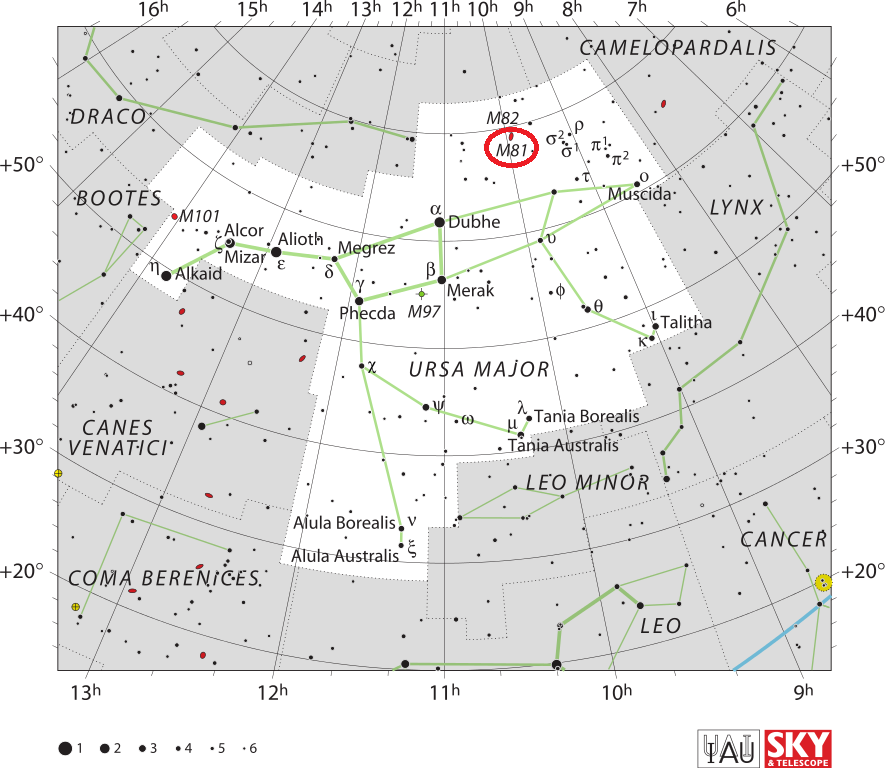Messier 81 (M81), also known as Bode’s Galaxy, is a grand design spiral galaxy located in the constellation Ursa Major. The galaxy lies at an approximate distance of 11.8 million light years from Earth and has an apparent magnitude of 6.94. It has the designation NGC 3031 in the New General Catalogue.
Messier 81 occupies an area of 26.9 by 14.1 arc minutes of apparent sky, which corresponds to a linear diameter of about 90,000 light years. It can easily be seen in binoculars, which only show a dim patch of light, and is best viewed in larger telescopes, which reveal details of the galaxy’s spiral structure. 3-inch telescopes show M81 as a hazy, bright oval-shaped patch of light, while 6-inch telescopes reveal the galaxy’s bright core surrounded by a faint halo.
Bode’s Galaxy can be found about 10 degrees northwest of Dubhe, Alpha Ursae Majoris. An imaginary line drawn from Phecda, Gamma Ursae Majoris to Dubhe and extended by roughly the same distance as that between the stars leads to M81.
The best time of year to observe M81 is during the spring.
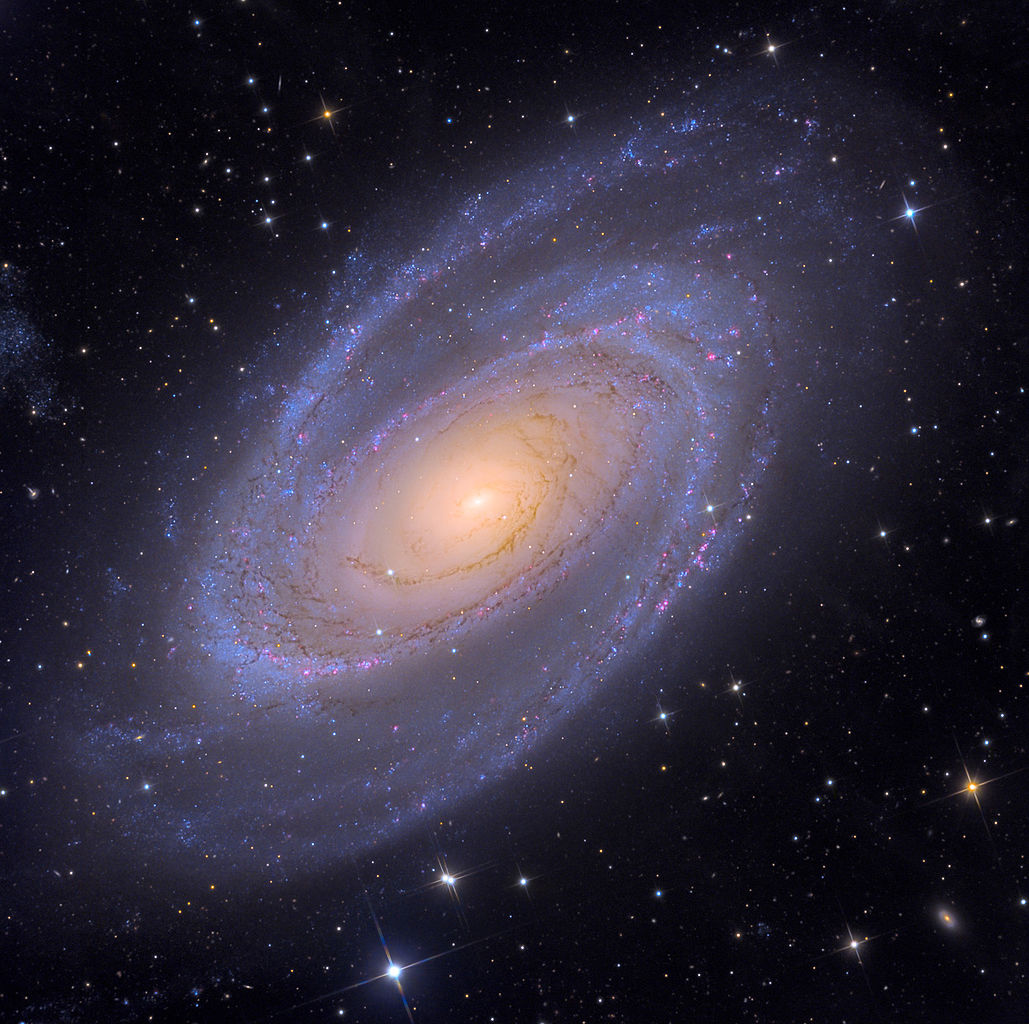
Several other members of the M81 Group, including the Cigar Galaxy (M82), are located in the same region of the sky. The Cigar Galaxy can be seen 38 arc minutes north of M81. The two galaxies can easily be seen in binoculars and small telescopes, but are not visible to the naked eye. M82 is smaller and fainter than M81, but is a wonderful example of a starburst galaxy and the two make a popular pair among astronomers. 8-inch and larger telescopes are required to make out the spiral structure in M81. The galaxy can be seen from northern latitudes, but is invisible to southern observers, except for those living near the equator.
With prominent, clearly defined spiral arms, Bode’s Galaxy is an excellent example of a grand design spiral. The galaxy’s size and proximity – it is one of the nearest galaxies beyond the Local Group – often make it a target of study by professional astronomers, while amateur astronomers and astrophotographers like to observe the galaxy because it is large and has a relatively high brightness.
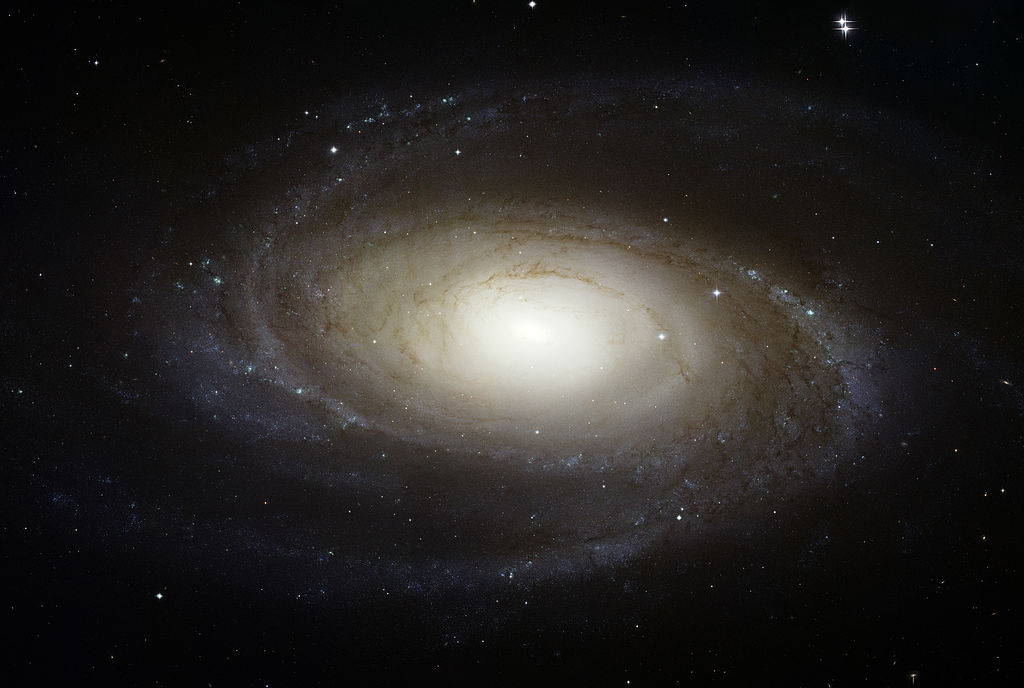
Bode’s Galaxy is home to over 250 billion stars. It is the most remote blueshifted (moving toward us) large galaxy known.
The active galactic nucleus of M81 contains a supermassive black hole with a mass of 70 million solar masses, or 15 times the mass of the black hole at the centre of the Milky Way.
Messier 81 has two well resolved spiral arms that contain large quantities of interstellar dust, associated with numerous starburst regions. Images of M81 taken at infrared wavelengths by the Spitzer Space Telescope have revealed that the interstellar dust is responsible for most of the infrared emissions detected in the galaxy. The hot, young, blue stars in the star forming regions of M81 heat the dust, increasing the emissions from these regions.
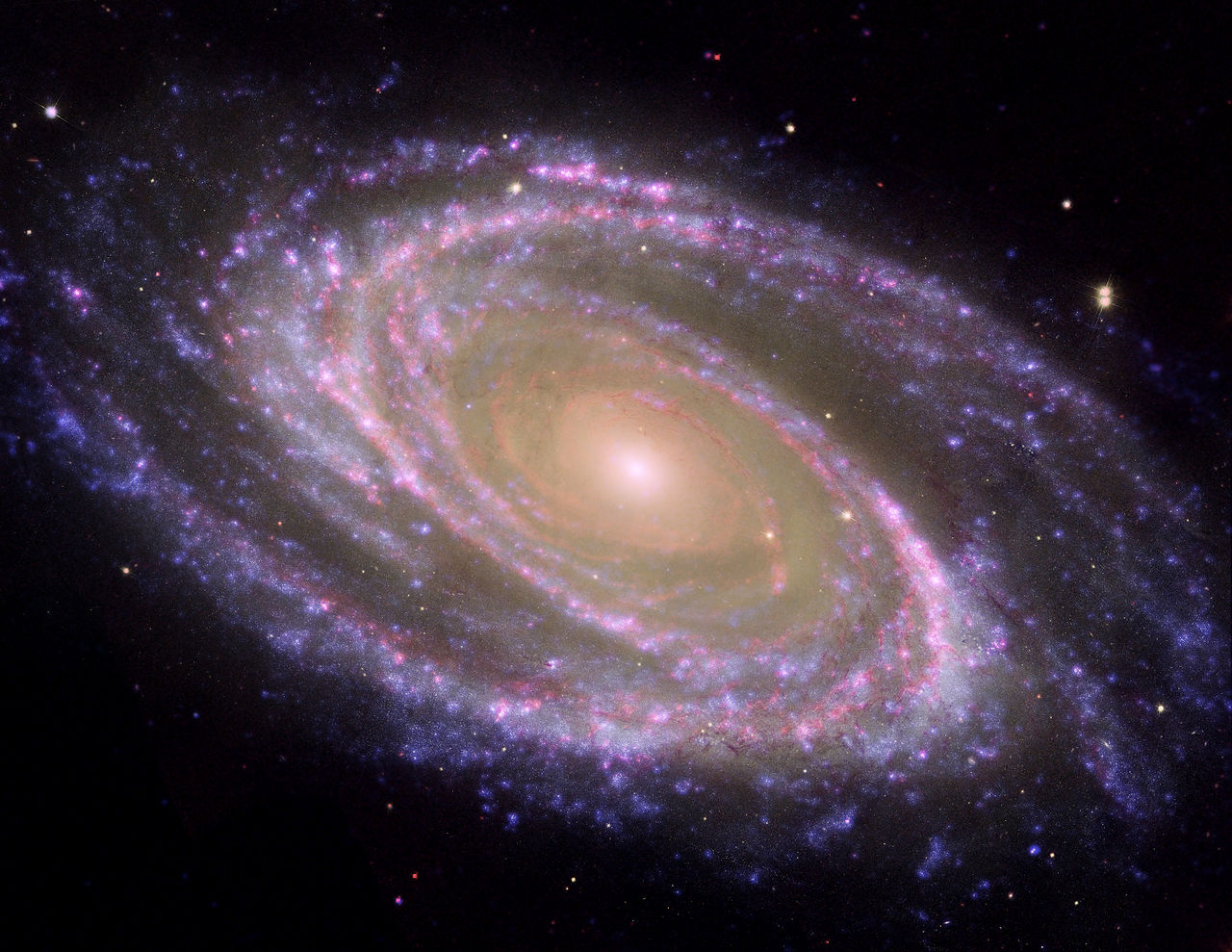
M81 is one of the brightest galaxies that can be seen from the Earth. It is high in the northern sky in the circumpolar constellation Ursa Major, the Great Bear. At an apparent magnitude of 6.8 it is just at the limit of naked-eye visibility. The galaxy’s angular size is about the same as that of the Full Moon.
This image combines data from the Hubble Space Telescope, the Spitzer Space Telescope, and the Galaxy Evolution Explorer (GALEX) missions. The GALEX ultraviolet data were from the far-UV portion of the spectrum (135 to 175 nanometers). The Spitzer infrared data were taken with the IRAC 4 detector (8 microns). The Hubble data were taken at the blue portion of the spectrum. Image – Hubble data: NASA, ESA, and A. Zezas (Harvard-Smithsonian Center for Astrophysics); GALEX data: NASA, JPL-Caltech, GALEX Team, J. Huchra et al. (Harvard-Smithsonian Center for Astrophysics); Spitzer data: NASA/JPL/Caltech/S. Willner (Harvard-Smithsonian Center for Astrophysics
Messier 81 is the largest member of the M81 Group of galaxies, a group that contains 34 galaxies located in Ursa Major. The M81 Group includes the Cigar Galaxy (Messier 82) and NGC 3077, two galaxies that are strongly affected by their large neighbour. The gravitational influence of M81 has left all three galaxies stripped of hydrogen gas. The interactions between the galaxies have allowed interstellar gas to fall into the central regions of Bode’s Galaxy and NGC 3077, which has triggered vigorous starburst activity there.
Bode’s Galaxy has 70 globular cluster candidates, detected in 1995, and an estimated total number of about 210 globulars.
A distance of 11 million light years was determined in 1993 using the Hubble observations of 32 Cepheid variables in the galaxy. The distance was later corrected using data from ESA’s Hipparcos satellite.
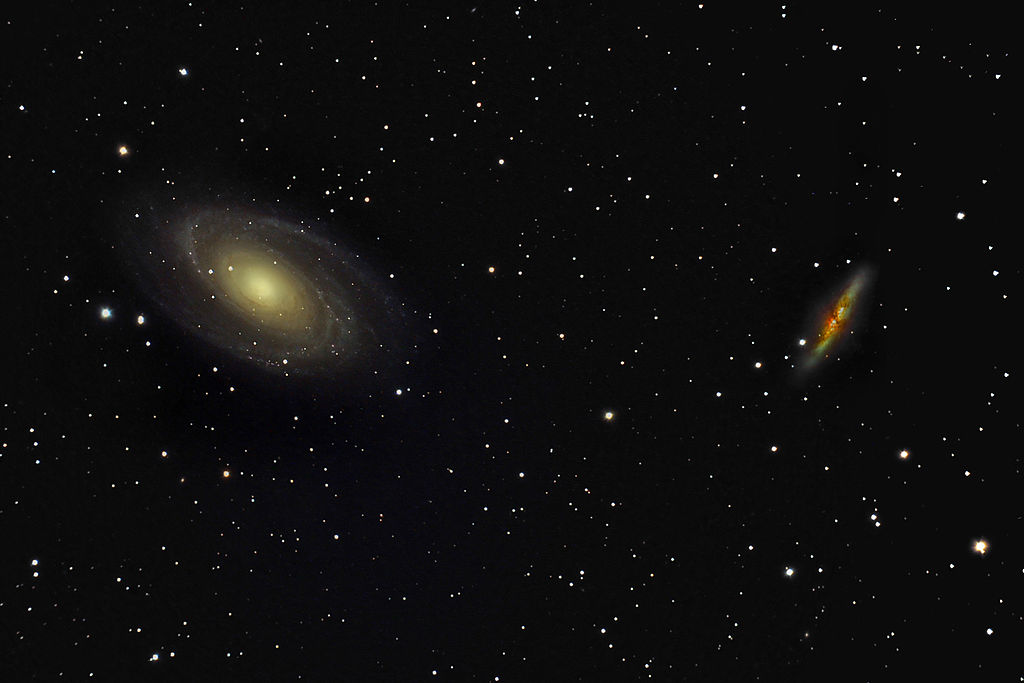
A supernova was observed in Bode’s Galaxy in 1993. Named SN 1993J, the supernova was first detected by the Spanish amateur astronomer Francisco Garcia Diaz on March 28 of that year. Reaching a maximum brightness of 10.5, it was the second brightest supernova event seen in the 20th century at the time of discovery.
SN 1993J was classified as a type IIb supernova, a transitory class between type II supernovae, caused by explosions of giant stars, and type Ib supernovae, triggered by the core collapse of massive stars. Observations of SN 1993J have indicated that types Ib and Ic were triggered by explosions of giant stars through processes similar to those seen in type II supernovae.
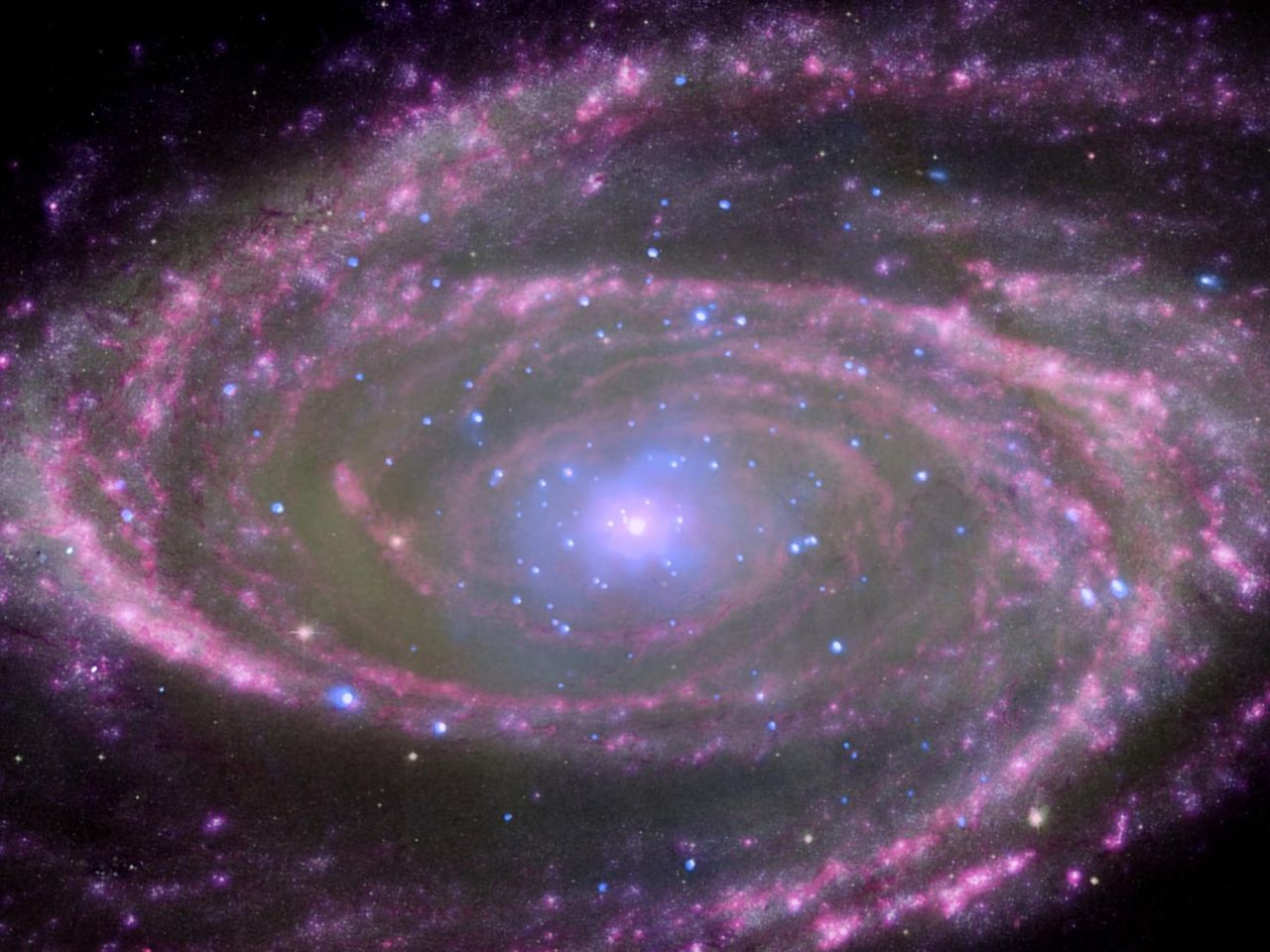
Bode’s Galaxy was named after Johann Elert Bode, the German astronomer who discovered it on December 31, 1774, along with the nearby Cigar Galaxy. He described the pair as “two small nebulae 3/4 degrees separated,” noting:
On December 31, I found through the seven-foot telescope, closely above the head of UMa, east near the star d at its ear, two small nebulous patches separated by about 0.75 degrees, the positions of which relative to the neighbored small stars are shown in the tenth figure. The patch Alpha [M81] appears mostly round and has a dense nucleus in the middle. The other, Beta [M82], on the other hand, is very pale and of elongated shape. I could determine the separation of Alpha to d as 2deg 7′, to Rho as 5deg 2′ and to 2 Sigma as 4deg 32′ with some accuracy; Beta was too faint and disappeared from my eyes as soon as I shifted apart the halves of the objective glass.
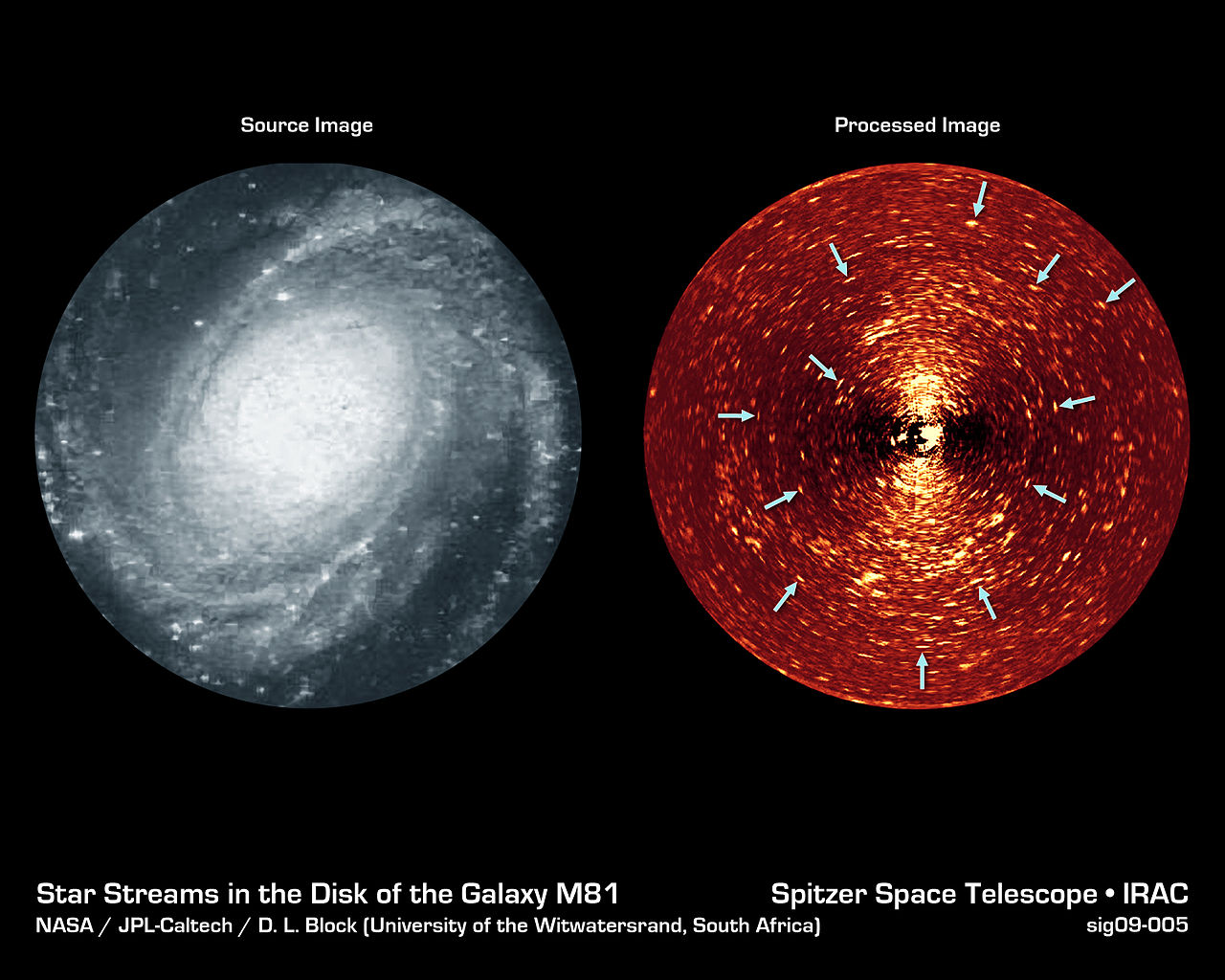
Pierre Méchain independently found M81 and M82 in August 1779 and reported the discovery to Charles Messier. Messier determined the positions of both objects and added them to his catalogue on February 9, 1781. He wrote:
A nebula near the ear of the great Bear, on the parallel of the star d, of fourth or fifth magnitude: its position was determined from that star. This nebula is a little oval, the center clear, & one can see it well in an ordinary telescope of 3.5 feet [FL]. It was discovered by M. Bode at Berlin on December 31, 1774, & by M. Méchain, in the month August 1779.
William Herschel observed the object a number of times. After seeing it in his large 10-foot telescope on November 26, 1810, he noted, “I viewed the nebula with the large 10 feet. It has a bright, resolvable nucleus, certainly consisting either of 3 or 4 stars or something resembling them. It is about 15 or 16′ long. The object was already too low to be seen to an advantage.”
John Herschel catalogued M81 as h 649 and later added it to the General Catalogue as GC 1949. He described the object as “Remarkable; extremely bright; extremely large; extended in position angle 156.0 degrees; gradually, then suddenly very much brighter toward the middle where there is a bright nucleus.”
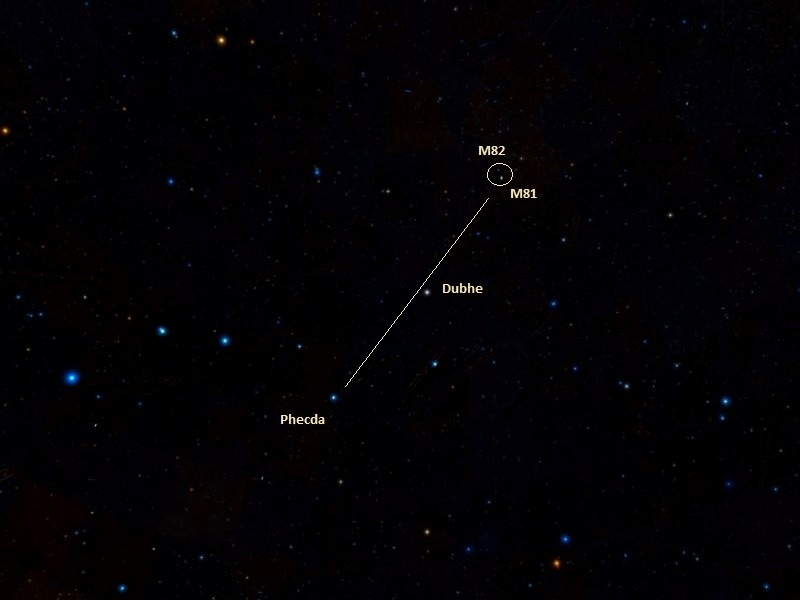
Admiral William Henry Smyth observed M81 in March 1837 and offered the following description:
No. 81 is a fine bright oval nebula, of a white colour, in the Great Bear‘s ear, which was first registered by M. Messier in 1781, and exhibited a mottled nebulosity to WH [William Herschel]. Its major axis lies np [north preceding, NW] to sf [south following, SE]; and it certainly is brightest in the middle. There are several minute companions [stars] in the field, of which a close double star in the sp [south preceding, SW] quadrant is No. 1386 in Struve’s grand Catalogue, and by him marked vicinae; the members are both of 9th magnitude, and trend np [north preceding, NW] to sf [south following, SE], about 2″ apart, forming a fine though difficult object.
With a low power, No. 82 M. can be brought into the north part of the same field of view, although they are half a degree apart. It is very long, narrow, and bright, especially at its northern limb, but rather paler than No. 81. A line drawn through three stars in the sp [south preceding, SW] to a fourth in the nf [north following, NE] passes directly through the nebula. The two nebulae precede Lambda, in the end of Draco‘s tail, by 25deg, but as the vicinity is deficient of large stars, they are not readily fished up.
The apparent place here taken, is that of a small star between the two nebulae, which was differentiated with 29 Ursae Majoris, and every care taken in the reduction. The bright star in the animal’s chest, south of 29, viz. Phi, is pronounced to be double, both companions being of the 5th magnitude, and only half a second asunder.
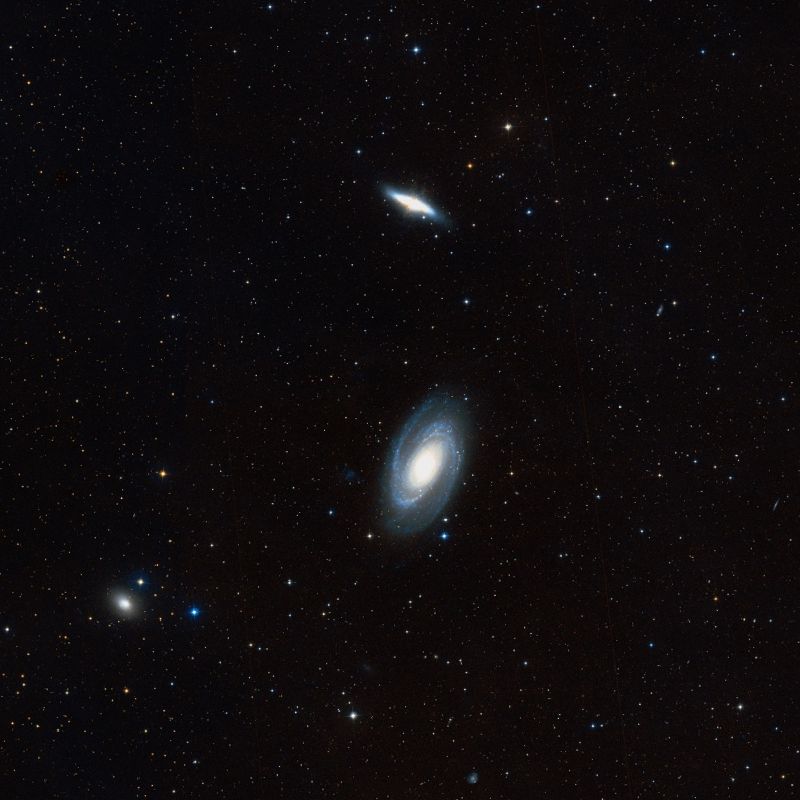
FACTS
| Object: Galaxy |
| Type: Spiral |
| Class: SA(s)ab, LINER |
| Designations: Messier 81, M81, Bode’s Galaxy, NGC 3031, PGC 28630, UGC 5318, 2E 2195, 2E 0951.4+6918, IRAS 09514+6918, 2MASX J09553318+6903549, MCG+12-10-010, RBS 808, Z 333-7, Z 0951.4+6918, SDSS J095533.16+690355.1, SDSS J095533.14+690355.2, SPB 115, TC 714, RORF 0951-693 |
| Constellation: Ursa Major |
| Right ascension: 09h 55m 33.2s |
| Declination: +69°03’55” |
| Distance: 11.8 million light years (3.62 megaparsecs) |
| Number of stars: > 250 billion |
| Apparent magnitude: +6.94 |
| Apparent dimensions: 26′.9 x 14′.1 |
| Radius: 45,000 light years |
| Heliocentric radial velocity: -34 km/s |
| Galactocentric velocity: 73 km/s |
| Redshift: −0.000113 |
LOCATION
